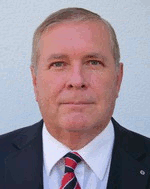 |
|
Biography
Siegfried Selberherr was born in Klosterneuburg, Austria, in 1955. He received the degree of Diplomingenieur in electrical engineering and the doctoral degree in technical sciences from the Technische Universität Wien in 1978 and 1981, respectively. Prof. Selberherr has been holding the venia docendi on Computer-Aided Design since 1984. From 1988 to 1999 he was the Head of the Institute for Microelectronics. From 1998 to 2005 he served as Dean of the Faculty of Electrical Engineering and Information Technology. His current research topics are modeling and simulation of problems for microelectronics engineering.
Preface
Welcome to the Institute for Microelectronics' 28th annual research review! Our staff, financed by the Austrian Federal Ministry of Science, Research and Economy, remain unchanged from last year and consist of eight full-time and four part-time employees: Five professors, one full-time and three part-time scientists, a secretary, and one part-time and one full-time technical assistant.
Our three part-time scientists, financed by the federal budget, have been upgraded to full employment with funds from scientific projects. In addition, twenty-six scientists are presently funded through projects supported by our industrial partners, the Austrian Science Fund (FWF), the Austrian Research Promotion Agency (FFG) and the Christian Doppler Gesellschaft (CDG), and by projects within the EC Framework Programme. Most of our separately funded scientists are also working towards their doctoral degrees. Thus, compared to the previous report, the number of additionally funded members of the institute is quite stable.
Over the last year, two projects, entitled SUPERTHEME ("Circuit Stability Under Process Variability and Electro-Thermal-Mechanical Coupling"), within the Information Society Technologies (IST) program, and MOSILSPIN ("Modeling Silicon Spintronics" – an Advanced Grant from the European Research Council), have been successfully completed. The IST projects, ATHENIS_3D and MoRV, the Christian Doppler Laboratory on "Reliability Issues in Microelectronics," as well as four projects funded by the Austrian Science Fund are proceeding according to plan.
We are very glad that our industrial partners have continued their cooperation, and that the Christian Doppler Laboratory on "High-performance Technology CAD" and the IST project SUPERAID7 ("Stability Under Process Variability for Advanced Interconnects and Devices Beyond 7 nm node") have been initiated. It is a great pleasure for us to report that an ERC Proof of Concept project, namely NOVOFLOP ("Non-Volatile Magnetic Flip Flop"), has also commenced.
We are very proud of the high academic and scientific output that our institute is producing. This is reflected in our respectable number of long-term projects and in an all-time-high number of publications, especially when it comes to contributing to and participating in international conferences. However, we are aware that this success is based considerably on our cooperating partners within academia and industry. We would therefore like explicitly to express our gratitude for their trust in our scientific work. In this sense, we are entering the next year of our institute, as ever, with high expectations.



